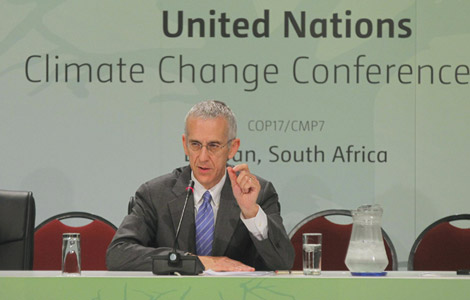Shattering the glass ceiling, breaking the mold
Updated: 2011-11-20 08:33
(China Daily)
|
|||||||||||
Documentary photography is a profession still very much dominated by men, but American photographer Susan Meiselas has broken the mold.

The 63-year-old Magnum photographer is one of the world's most socially engaged photographers and has been positioned as the leading voice in contemporary documentary photography practice.
"Working in environments which are dominated by man, not just in Magnum, but also in the larger world in this field, women are often less expected from others, but we may still expect a lot from ourselves," says Meiselas. She was speaking on the sidelines of the US-China Forum on the Arts and Culture.
She is best known for her coverage of the political upheaval in Nicaragua in the 1970s and 1980s, and the human rights issues in Latin America.
Her work has been recognized with some of the most prestigious awards in her field throughout a career spanning more than 30 years. They include the Robert Capa Gold Medal Award from the Overseas Press Club "for outstanding courage and reporting" in 1979, and she was named a MacArthur Fellow in 1992, an award to talented individuals who have shown extraordinary originality and dedication in their creative pursuits.
Meiselas is committed to photography as a lifelong pursuit.
She is still keen to capture thought-provoking moments with her camera by taking adventurous trips to some of the world's most dangerous places. For her, the unpredictability means opportunities other than risks.
"Photography gives you this tremendous opportunity to explore and endlessly discover, there is always something unexpected when you travel and when you cross boundaries of borders.
"I see the world through photography, through imaging images. I am led by my eyes. Photography has become a natural part of my life."
Meisela's talent was first spotted by the Magnum photographer Gilles Peress in 1976, who took her first in-depth portfolio of a collection of black and white shots of carnival strippers' lives on and off stage in New England, Pennsylvania, and South Carolina, to Magnum Photos, the leading international photographic cooperative headquartered in New York. Magnum invited Meiselas into the group the same year and she has become one of their most active photojournalists.
Meiselas says women photographers have the advantage of disarming, as they can become invisible more easily and just blend into the settings.
"I guess my approach is to be more assimilated into the setting, to immerse myself. I have a sense we work sort of behind the scenes quietly. It can be a different performance for men."
She says the study of anthropology has given her the ability to look at people in a non-judgmental way, and journalistic values let her take insightful pictures that deliver rich connotations other than just visual impact.
"I am not just intuitive in making photographs, I really want to understand what's going on, so in that sense, I have a journalistic orientation."
In addition to photography, Meiselas also undertakes other work.
While she is in Beijing, she is the co-curator of Coal + Ice, an exhibition featuring the works of 30 photographers from around the world, brought together to visually narrate the hidden chain of actions triggered by mankind's use of coal. Meiselas chose the images on display.
Meiselas says she was struck by the quality of work of Chinese photographers, and anticipates more cooperation with her Chinese counterparts.
She says if she had to explore something in China, she would follow the trail of young migrant workers, especially women, to see the dramatic changes in their lives. Her interest was triggered by a trip to small villages in Pingyao county in Shanxi province several years ago.
You can contact the writer at liulu@chinadaily.com.cn.
China Daily
Hot Topics
HIV/AIDS, Egypt protest, Thanksgiving, climate change, global economic recovery, home prices, high-speed railways, school bus safety, Libya situation, Weekly photos
Editor's Picks

|

|

|

|

|

|







